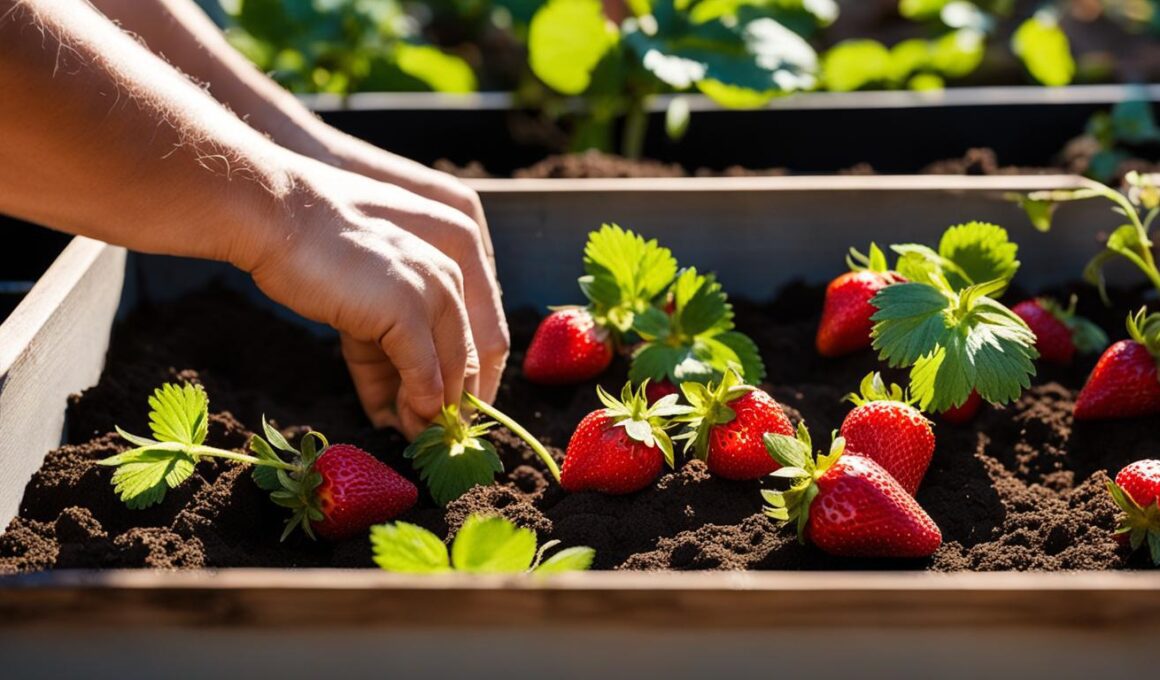Transplanting strawberries at the right time is crucial for the health and productivity of your plants. Knowing when to transplant strawberries can result in healthy plants and bountiful harvests. It’s important to prevent overcrowding, as too many plants competing for resources can negatively impact fruit production. Transplanting allows you to separate and move new plants produced by your original strawberry parent plants, ensuring each plant has enough space to thrive.
Transplanting strawberries at the right time is crucial for the health and productivity of your plants. Knowing when to transplant strawberries can result in healthy plants and bountiful harvests. It’s important to prevent overcrowding, as too many plants competing for resources can negatively impact fruit production. Transplanting allows you to separate and move new plants produced by your original strawberry parent plants, ensuring each plant has enough space to thrive.
Signs that strawberries need to be transplanted
Knowing when to transplant strawberries is crucial for the health and productivity of your plants. To determine the right time, keep an eye out for the following signs:
- Emergence of runners: Look for horizontal stems or runners that produce new strawberry plants. These runners serve as indicators that your plants are ready to be transplanted.
- Development of leaves and root nodes: Once the runners have emerged, observe if they have developed leaves and multiple root nodes. This is a clear sign that your strawberries are mature enough to be transplanted to a new location.
It’s important to note that the timing for transplanting strawberries may vary depending on the success of your parent plants and the specific cultivar you are growing. In general, these signs become evident in late spring and throughout the summer.
When to transplant strawberries: The 2 best times
The best times to transplant strawberries are in spring and fall. These seasons provide optimal conditions for successful transplantation, allowing the plants to establish strong roots and produce abundant fruit.
Spring: When spring arrives, it’s the perfect time to relocate established runners or install new parent plants in your garden. The moderate temperatures and increasing daylight hours encourage rapid root development and the formation of fruiting buds. By transplanting strawberries in spring, you give them a head start in their first season, ensuring a more vigorous harvest the following spring.
Fall: As temperatures begin to cool in fall, it’s another opportune time for transplanting strawberries. You can carefully move runners or divided parent plants to a new bed, allowing them to establish themselves before winter arrives. Remember to provide your transplants with adequate nutrients and protection against frost during the colder months.
Transplanting strawberries during both spring and fall maximizes their chances of thriving in their new location. Whether you choose to transplant in spring for a robust harvest the following year or in fall to give them a head start before winter, these two seasons offer the best conditions for successful transplantation.
Benefits of transplanting strawberries in spring:
- Optimal root development and fruiting bud formation.
- A more vigorous harvest the following spring.
Guidelines for fall transplanting:
- Choose a cooler period when temperatures have started to drop.
- Take extra care when moving runners or divided parent plants to a new bed.
- Provide essential nutrients and protect plants from frost during winter.
What to do with Strawberry Runners
When it comes to strawberry runners, you have several options to consider. Each option offers its own benefits and can help you make the most out of your strawberry plants. Whether you’re looking to expand your strawberry patch, share plants with friends, or improve growth and yield, here are some options to explore:
1. Relocate to a New Strawberry Patch
If you have a suitable location, you can relocate your strawberry runners to an entirely new strawberry patch. Choose a spot that receives ample sunlight, has well-drained soil, and is free of harmful fungal diseases. This will provide your runners with a fresh start and ensure optimal growth and productivity. Take care to space the transplanted runners adequately, allowing each plant enough room to thrive and produce abundant fruits.
2. Transplant Strawberries into Pots
If you prefer a more versatile approach, transplanting strawberries into pots is an excellent option. This allows you to easily share plants with friends, give them as gifts, or move them around your garden for aesthetic purposes. Select pots with sufficient drainage holes and fill them with nutrient-rich soil. Place the runners carefully into the pots, ensuring the crowns are level with or slightly above the soil surface. Water the transplanted strawberries thoroughly, and remember to provide regular care and maintenance to promote healthy growth.
3. Utilize the Matted Row System
The matted row system is an effective technique for growing strawberries, especially if you have limited space or prefer a low-maintenance approach. This method involves allowing the strawberry runners to grow and form a dense mat, creating a continuous row of plants. To implement the matted row system, select a designated area in your garden and prepare the soil by adding organic matter and removing weeds. Plant your parent strawberry plants or transplanted runners in rows, and allow the runners to take root and multiply. Apply a generous layer of mulch, such as straw or wood chips, around the plants, ensuring the crowns are exposed. This system provides ample space for the runners to spread and grow, resulting in a dense, productive bed of strawberries.
The key to success is choosing the option that best suits your needs and growing conditions. Whether you decide to relocate runners, transplant strawberries into pots, or utilize the matted row system, each method offers its own benefits and can contribute to the overall success of your strawberry garden.
Should you divide the plants when you transplant them?
Dividing strawberry plants can be a beneficial practice when transplanting them, especially in certain situations. If you have robust parent plants with limited space, dividing them through crown division can provide extra room for each individual plant to grow and thrive. It can also be useful for cultivars that don’t produce many runners.
To successfully divide the parent plants, start by thoroughly watering them. This will make it easier to dig them up without causing damage to the roots. Once the plants are well-hydrated, carefully dig around the base of each plant, making sure to avoid cutting through any healthy roots.
Next, use a sharp garden knife to evenly divide the crowns of the parent plants into separate sections. Ensure that each division has strong roots attached to it. This will promote healthy growth once the plants are transplanted.
After dividing the plants, it’s important to transplant the new divisions immediately. Choose a location with suitable soil and lighting conditions for strawberries. Dig individual holes for each plant division, making sure to space them adequately to allow for their growth. Gently place the divided plants into the holes, covering their roots with soil, and firming it gently around them.
Once transplanted, watering the new divisions thoroughly is crucial. This will help to settle the soil around the roots and encourage the plants to establish themselves in their new location. Regular watering and monitoring of the plants’ progress will ensure their successful growth and development.
Dividing strawberry plants through crown division can be a beneficial technique to create additional space for healthy growth and maximize the productivity of your strawberry garden. By following these simple steps, you can successfully divide and transplant your strawberry plants, setting them up for a fruitful future.
Conclusion
Transplanting strawberries at the right time is crucial for the health and productivity of your plants. By following proper transplanting techniques, you can ensure healthier plants and bountiful harvests in your strawberry garden.
Spring and fall are the best times to transplant strawberries, as this allows them enough time to establish and develop strong roots before winter or the next growing season. Look out for signs indicating when to transplant strawberries, such as the emergence of runners and the development of leaves and root nodes. These are clear indications that your plants are ready to be relocated.
When transplanting strawberries, you have various options to consider. You can relocate runners to new beds, ensuring they have sufficient sunlight, well-drained soil, and protection from harmful fungal diseases. Alternatively, you can transplant strawberries into pots, making it easier to share with friends or position them flexibly in your garden. The matted row system is another option, training runners to grow into mulched rows for optimal space and growth.
In certain cases, dividing parent plants can be beneficial. This can provide extra room for individual plants and is especially useful for cultivars that don’t produce many runners. To divide parent plants successfully, water them well, dig them up, and use a sharp garden knife to evenly divide the crowns. Transplant the new divisions immediately and water them thoroughly to ensure their healthy growth.
Can Fertilizing Strawberries Affect the Timing of Transplanting?
When considering the timing for transplanting strawberries, it’s important to factor in fertilizing. Following a fertilizing strawberries timing guide can help ensure that the plants are at their healthiest when it’s time to move them. Proper fertilization can affect the timing of transplanting by promoting strong, robust growth.










